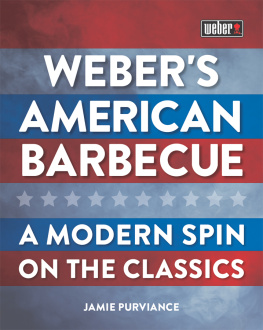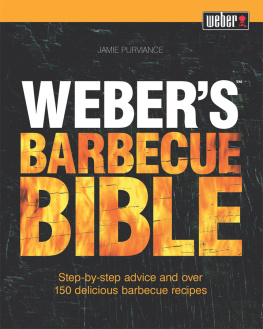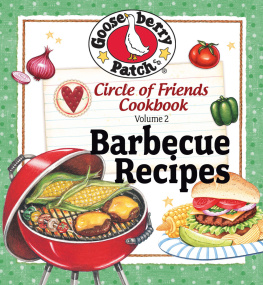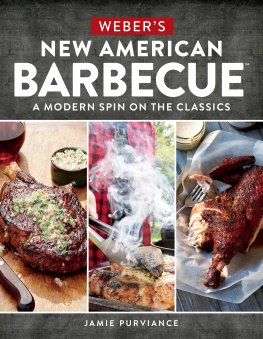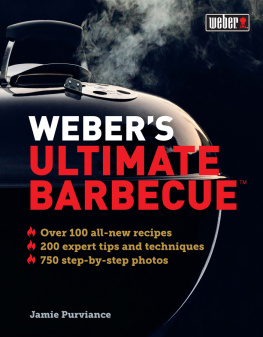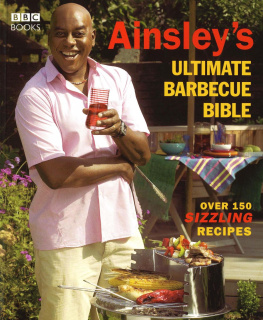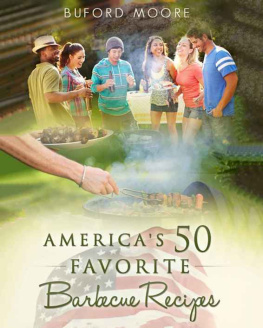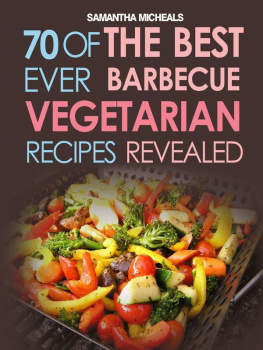INSPIRED BY TRADITION. FREED BY CREATIVITY.
THIS IS BARBECUE, AMERICAN STYLE.
Go beyond the traditional and get a taste of the new, authentic American barbecue. Webers American Barbecue is an exciting, hands-on exploration of how barbecue is evolving. Fresh, modern and totally original, this book tours some of the most interesting trends in barbecue today.
Featuring places of interest, local experts, over 120 recipes and the history behind themyoull feel like youre taking a road trip across America.
This definitive cookbook shares whats happening in American barbecue and brings contemporary, extraordinary barbecue within everyones reach.
ABOUT THE AUTHOR Jamie Purviance is a graduate of Stanford University and the Culinary Institute of America. He is an accomplished chef and teacher who has helped millions of people to barbecue like professionals. He is a regular contributor to national newspapers and magazines in America and is the author of many best-selling cookbooks, including Webers Barbecue Bible .
WHATS NEW IN
BARBECUE?
WHAT WAS ONCE A STYLE OF FOOD ROOTED IN RURAL SOUTHERN AMERICA IS NOW ALMOST EVERYWHERE, EVEN IN BIG CITIES, AND, IN TURN, THOSE CITIES ARE INFLUENCING THE FOOD.
B arbecue. Surely youve heard of it, but what exactly is it? I used to think I knew. It was supposed to be spice-rubbed pork ribs glistening with sauce, or tender slices of smoked brisket dripping juices on paper or succulent shreds of pork shoulder piled high on soft white buns. Those were supposed to be the epitome of barbecuean American institution that has held tightly to strict principles since the first days of our nation. At least that is what I thought. Several years ago I accidentally offended a fellow student at the Culinary Institute of America by inviting him to a weekend barbecue where I intended to cook hamburgers and sausages on a barbecue grill. He was raised in North Carolina with more than a little local pride, and so he responded indignantly, Thats not barbecue. Real barbecue is cooked in a pit with wood, not on a grill. Then he schooled me about serious regional differences in barbecue. Maybe you have heard of these. In the Piedmont of North Carolina, barbecue means pit-cooked and chopped pork served in a tomato-tinged vinegar sauce with slaw and hush puppies on the side. No beef is allowed. But in Texas proper, barbecue is beefespecially brisket and hefty beef ribsand pit masters there are likely to protest at anyone coating it with sauce or trying to eat it with a fork. On and on my classmate went, pounding his fists on the table and telling me you cant possibly cook barbecue with gas. You have to do it like third-generation pit master Sam Jones at Skylight Inn BBQ in Ayden, North Carolina, where a billboard outside the legendary restaurant clearly states, If its not cooked with wood its not BBQ. Well, okay, I assumed my red-faced classmate had sufficient credentials that I should believe him. I filed away his lesson about what authentic barbecue means, and for years I tended to agree with it. While writing this book, however, I felt compelled to check his facts and to dig a little deeper. Among other things, I wanted to know about the origins of American barbecue. It turns out that American barbecues starting point was barbacoa , which dates to the 1500s: a framework of green branches and sticks elevated high over a fire for cooking. Thats how barbecue was practised in a region that is now the West Indies and along the south-eastern coast of North America, including Florida. Just to be clear, those Indians were not cooking racks of baby back ribs or smoky briskets to be sliced for barbecue sandwiches. No, no, no. They were cooking fish, turtles, iguana, alligator and snakespretty much anything they could catch and slaughter. So if you really want to talk about authentic American barbecue, maybe we should forget the pulled pork sandwiches and think instead about how to roast an alligator over a campfire.

In fact, maybe we should forget the whole question of whats authentic. Clearly, with barbecue, the food evolves over time with cultural changes. Today, brisket seems like it is permanently enshrined along with beef ribs and sausage as part of the holy trinity of Texas barbecue meats. Historically speaking, however, brisket is a relatively new thing, and soon it might be replaced (check out the timeline on the facing page). What was once a style of food rooted in rural Southern America is now almost everywhere, even in big cities and, in turn, those cities are influencing the food. At Hometown Bar-B-Que in Brooklyn, New York, pit master Bill Durney is a lot more creative than he ever would be in Central Texas where he did his barbecue training. On Durneys menu you will find sweet Korean sticky ribs, a Vietnamese-style lamb belly banh mi sandwich with crunchy daikon and spicy jerk baby back ribs. Why? The people in Brooklyn, some of them from Korean, Vietnamese and Caribbean backgrounds, like their distinctive international flavours in their barbecue.


